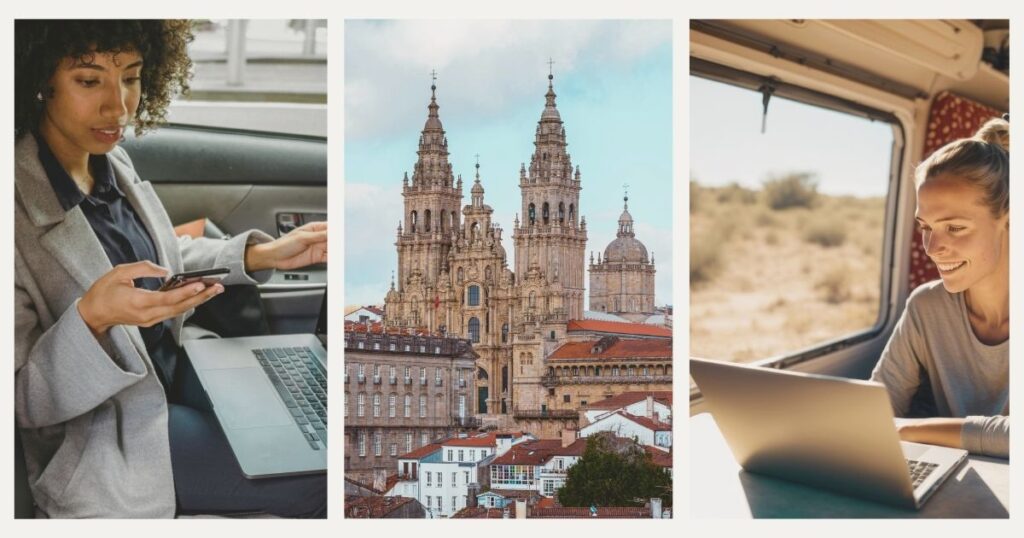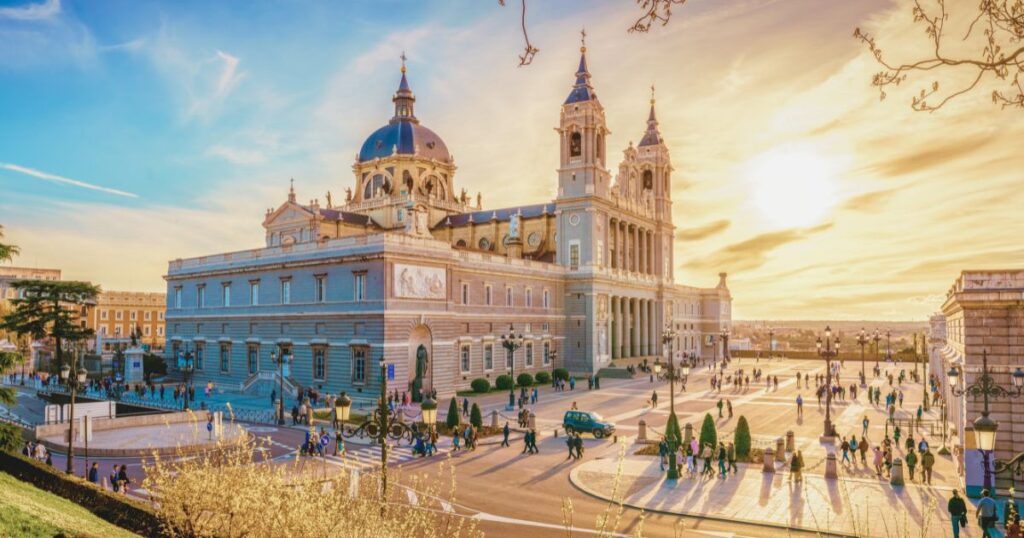Spain is one of the world’s top tourist destinations, just behind France, and has become a favorite spot for digital nomads. With its European advantages, rich culture, great climate, and affordable cost of living, it’s an ideal place for remote work. Nomada has created this comprehensive guide for digital nomads in Spain, offering all the essential information you need to live and work remotely.
From the requirements and steps necessary to obtain the digital nomad visa to the best cities to set up your base camp, through advice on the cost of living, the accommodation options you have and the community of digital nomads in Spain.
Throughout this guide you will learn how to process your digital nomad visa, where to find the best coworking spaces and tips for transportation. The 360º experience.
Join us to discover everything you need to know to start your adventure as a digital nomad in Spain. The country that gave life to artists like Picasso, Dalí or Cervantes is waiting for you to start creating a bright future.
Visa to work remotely as a digital nomad in Spain

Applying for a visa to work remotely as a digital nomad in Spain is an essential step for anyone who wants to settle in the country.
This visa, specifically designed for digital nomads, allows those who work remotely to live legally in Spain while continuing with their professional activities for companies located outside Spanish territory. Obtaining this visa not only ensures compliance with immigration laws but also facilitates access to local services and the possibility of fully integrating into Spanish daily life.
The procedure to obtain a digital nomad visa in Spain can vary in duration, but generally, the complete process takes between 10 and 20 working days from the submission of the application. Among the most outstanding benefits of this visa is the possibility of residing in Spain for up to a year, with the option of renewing the authorization for a maximum period of three years, and even obtaining permanent residence after this time. In addition, this visa allows digital nomads to enjoy an optimized tax regime.
To learn how to complete the entire process, consult our article on the visa for digital nomads in Spain.
Temporary accommodation for digital nomads in Spain

Finding the best temporary accommodation in Spain is essential for digital nomads to land comfortably and explore what are the best options for their passage through the country.
In Spain, there are several accommodation options that adapt to different needs and budgets. Among the most common are short-term rentals and colivings, which include furnished apartments, studios, and rooms in shared apartments. These are ideal for weekly and monthly stays.
The characteristics of temporary accommodations vary by area. In cities like Madrid and Barcelona, it is common to find modern, well-equipped apartments located in central, well-connected neighborhoods. Other cities, such as Valencia, Seville, and Malaga, also offer a wide variety of options, from apartments near the beach to homes in charming historic areas. Many even have coworking areas because they are designed for nomadic life or, at least, for people who work in technological and creative sectors.
In addition, there are specialized platforms and agencies that facilitate the search for temporary accommodation in Spain, guaranteeing safe and quality options.
Internet access for digital nomads in Spain
There is no doubt about it: digital nomads need reliable and fast internet. It is essential to maintain productivity and work in a comfortable way.
In Spain, there are several options for connecting to the internet, both at home and through mobile devices. Home internet connections are usually via fiber optics, with average download speeds of 100 Mb up to 1 Gb. These speeds are ideal for tasks that require high data consumption, such as video calls and uploading large files. Companies such as Movistar, Vodafone, Orange, and DIGI are some of the main suppliers. They usually offer plans with good stability and relatively competitive prices.
In Spain, the main operators offer 4G and 5G plans, which provide fast speeds and stable connections in most urban and rural areas. The average speed of 4G mobile connections in Spain is around 30-50 Mbps, while 5G can reach much higher speeds, although its coverage is still expanding.
However, in some rural or remote areas, the internet connection may be less reliable and slower. In these cases, a portable router, satellite internet services, or WiMAX can be a viable solution. Spain has many interesting rural areas, so we recommend that you investigate internet coverage in the specific areas where you plan to stay. As they say on this earth, prevention is better than cure.
How to get around as a digital nomad in Spain?

Spain has a well-developed transport infrastructure, with both public and private options. Here, we present a complete guide on the country’s main means of transport, their quality of service, prices, and times, along with all the necessary information to help you choose the best alternative for your mobility needs.
Public transport
1. Trains
Renfe, Spain’s national railway company, operates an extensive network of trains that connect cities and regions throughout the country. High-speed trains (AVE) are usually quite efficient and, above all, fast. They connect cities like Madrid, Barcelona, Valencia, and Seville in a few hours. In fact, to reach the central node, Madrid, it usually takes a couple of hours, approximately. There are also connections with other European cities, such as Marseille.
Ticket prices vary according to the route and class, but an average AVE trip can cost between 30 and 100 euros. Regional and commuter trains are cheaper, with prices ranging from 5 to 25 euros. Waiting times are minimal and punctuality is an outstanding feature of the railway service in Spain. However, if you travel at times of high traffic – working days at work, for example – it is important that you arrive with a margin to avoid problems.
2. Coaches
The bus service in Spain is operated by several private companies, such as Alsa, Avanza, and Socibus, which offer intercity and regional routes. Buses are an economical option to travel, with tickets that usually cost between 10 and 40 euros depending on the distance. Urban buses in cities such as Madrid and Barcelona are managed by municipal companies, and that makes the rates affordable (1.50 euros in Madrid, and 2.55 in Barcelona). The frequency of city buses is high, especially during peak hours, although travel times can be longer due to traffic and the number of stops.
3. Metro
The subway is a fast and efficient way to travel within Spain’s main cities. Madrid and Barcelona have extensive metro systems that cover most of the cities’ points of interest. Other smaller cities, such as Seville or Valencia, also offer this means of transport.
Single tickets cost around 2 euros, and there are options for monthly subscriptions. The quality of service is high, with trains running with frequencies of 2 to 5 minutes during peak hours. The subway is punctual and safe, which makes it a popular option among residents and visitors.
4. Private transport
4.1. Taxis and VTC
Taxis in Spain are a convenient option for short trips and when speed is needed. The initial rates vary between 3 and 4 euros, with extra costs for distance and time. An average trip within the city can cost between 10 and 20 euros. Taxis are widely available in urban areas and can be booked through mobile apps or by calling a local taxi company. The quality of service is generally good, with professional drivers and well-maintained vehicles. And in almost all medium and large cities you have available Uber and Cabify, the two large VTC companies that operate in Spain.
4.2. Car rental
Renting a car is a more than interesting idea for those who want to explore the country at their own pace. From Nomad to Nomad: if you really want to know Spain (the good way), we recommend that you opt for this option and explore cities that are generally off the most mainstream radar, such as León, Badajoz, A Coruña or Ronda.
Several car rental companies, such as Hertz, Avis, and Europcar, offer a wide range of vehicles. Rental prices vary depending on the type of car and the duration of the rental, but a compact car can cost between 40 and 80 euros per day. Additional costs such as insurance, gasoline, and tolls should be considered. Take out the calculator, make a few sums, and if the budget fits you.
4.3. Electric bicycles and scooters
Electric bicycles and scooters are increasingly popular in Spanish cities, thanks to their sustainability and ease of use. Many cities have rental services, such as BiciMAD in Madrid, Bicing in Barcelona, and Sevici in Seville, where you can rent bicycles by the hour or through subscriptions. Prices are affordable, with rates ranging from 1 to 2 euros each way or monthly subscriptions of around 20 euros. Electric scooters are also available through applications such as -Lime, Bird…- and the rates are similar. An ideal and ecological means of transport for short distances.
What is there to eat and drink? Gastronomy in Spain for digital nomads

Digital nomads in Spain also love it as a culinary paradise, with its wide variety of dishes that reflect a rich history and deep culture. From traditional recipes to modern offerings, the country offers something for all tastes, also vegetarians and vegans. Remember: we talk about the country with the best chef in the world in 2021, 2022 and 2023, David Muñoz, and one of the most recognized and valued cuisines worldwide.
Keep reading. We present a guide on what to eat in Spain, highlighting some of the country’s most important and popular restaurants.
1. Traditional dishes
Spanish cuisine is famous for traditional dishes such as paella, a specialty of the Valencian Community made with rice, meat, and vegetables. Another iconic dish is the Spanish omelet, a mixture of egg and potatoes served in bars and restaurants throughout the country. Tapas, small portions of food served as an appetizer or directly to eat in a varied way, are another essential part of the Spanish gastronomic experience. Patatas bravas, Iberian ham, Andalusian squid… I’m sure they sound familiar to you.
2. Traditional drinks
Spain’s traditional drinks are a fundamental part of its gastronomic culture. At the top of the poster, we can place Spanish wine, which enjoys a worldwide reputation for its quality and diversity. From the robust reds of La Rioja to the fresh whites of Rías Baixas, each wine region offers its own wine gems.
Another essential drink is sangria, a refreshing mixture of red wine, fruits and spices, perfect to enjoy on a sunny terrace.
And here comes a pro tip: if in the bars you order the also famous summer red, a combination of red wine and lemon or orange soda, you have more options to be served a drink that the locals really drink. As the tourist usually asks for sangria, thanks to its fame, it is more common for prices to be high and the quality a little lower.
For those who prefer something stronger, try herbal liqueur. The traditional Galician “orujo” or the “orujo cream” are ideal options for concluding a meal.
And, of course, you can’t talk about Spanish drinks without mentioning the emblematic beer, with local brands such as Mahou, Estrella Galicia or Cruzcampo, which offer a wide range of styles for all tastes.
3. Featured restaurants
Restaurante Botín – Madrid
According to Guinness World Records, Botín is the oldest restaurant in the world. Located in Madrid, it is famous for its roasted suckling pig and roasted lamb. The restaurant offers an authentic experience of Castilian cuisine, and its historic atmosphere adds a special charm to the visit. Names such as Goya, Hemingway, and Truman Capote have passed through it.
El Celler de Can Roca – Girona
One of the best restaurants in the world, the Roca brothers run it. It offers innovative and sophisticated cuisine, combining modern techniques with traditional ingredients. It is a mandatory stop for lovers of haute cuisine. Of course, you will need months—or a lot of luck—to get a reservation.
Casa Morales – Sevilla
Seville, another of the great historical cities in the world – it was a connection point with America from the 16th century – has a broad and rich offering. An example of this is Casa Morales, a place that opened in 1850, located next to the largest Gothic cathedral in the world. Tradition in its pure state.
4. Vegetarian and vegan options
Teresa Carles – Barcelona
Teresa Carles is a reference for vegetarian and vegan food in Barcelona. Its menu includes a wide variety of healthy and delicious dishes, from creative salads to vegetarian burgers.
Vega – Madrid
Vega is a vegan restaurant in Madrid that offers dishes made with fresh, seasonal ingredients. The menu includes options such as vegan tacos, vegetable curry, and desserts without animal products.
Gastronomic markets and fairs
In addition to restaurants, markets and food fairs are excellent places to explore Spanish food. The San Miguel Market in Madrid and La Boquería in Barcelona are two of the most famous markets. In them you can try tapas, fresh seafood, sausages and much more. Here the kings are the local products, and if you move away from the most famous, you can also soak up the atmosphere and the local culture.
How to access health services as a digital nomad in Spain

Spain has a high-quality health system, internationally recognized for its efficiency and first-class medical care. The country has a wide network of clinics and hospitals, both public and private, that offer advanced and specialized medical services.
Health system in Spain
The health system in Spain consists of a network of hospitals and public and private health centers. Public hospitals are managed by the National Health System (SNS) and offer free care to residents and citizens of the European Union. Among the most prestigious hospitals are the La Paz University Hospital in Madrid, the Hospital Clínic in Barcelona and the Virgen del Rocío University Hospital in Seville. These centers are known for their modern facilities, highly qualified staff and a wide range of services so that you can exercise your nomadic life with total peace of mind.
Travel insurance and international health insurance for digital nomads in Spain
For digital nomads, it is essential to have travel insurance or international medical insurance that covers medical expenses in the event of illness or accident. Among the most recommended specialized insurance options for digital nomads in Spain we can find three:
SafetyWing. Ideal for digital nomads in Spain, SafetyWing offers global medical and travel coverage with flexible purchase options and automatic renewal. With prices starting at $56.28 per month, it is an interesting option for those seeking protection while working and exploring new destinations from Spain.
World Nomads. Perfect for digital nomads in Spain because it provides medical and travel coverage worldwide with the option of renewal during the trip. With monthly rates starting at 70 euros, it covers adventure activities and extreme sports. Peace of mind for active travelers.
Integra Global. Recognized for its wide medical and travel coverage worldwide, Integra Global is a solid option for digital nomads working in Spain and other types of expats. They offer specialized treatments such as psychology, dental and ophthalmology.
Quality of the health system
Spain is known for its high-quality health system. According to various studies and international rankings, the country is among the best in the world. Medical professionals are highly trained, and hospitals have state-of-the-art technology. In addition, the public health system ensures that all residents have access to free or low-cost medical care.
Basic first aid elements
For digital nomads in Spain, it is essential to carry a first aid kit that includes:
- Analgesics and anti-inflammatories. To relieve pain and reduce inflammation.
- Antiseptics and disinfectants. To clean and disinfect wounds.
- Band-aids and bandages. To cover and protect cuts and scrapes.
- Personal medicines. Any medication you need regularly.
- Thermometer. To measure body temperature.
- Insect repellent and sunscreen. Especially useful in hot areas and with high sun exposure.
Currency and payment methods in Spain

In Spain, the official currency is the euro (EUR), which is used throughout the eurozone, with countries such as Germany, France, and Italy. The euro is a strong and stable currency, which makes it a reliable option for digital nomads looking for a solid economy during their stay. The exchange rate of the euro against the US dollar (USD) may fluctuate, but it generally remains in a stable range. It is advisable to consult an updated currency converter before making important transactions.
1. Means of payment
In Spain, the most common methods of payment include debit and credit cards, bank transfers, and cash. Credit and debit cards from networks like Visa, Mastercard, and American Express are widely accepted at most establishments, including stores, restaurants, and hotels. Additionally, payments made through mobile applications such as Apple Pay, Google Pay, and Samsung Pay are also popular and accepted at many businesses.
2. Cash payment
Although card and electronic payments are very common, there are still situations in which cash is useful. Small shops, local markets, and some services may prefer cash payments—or even be the only option. Although the use of cash is gradually decreasing in favor of more modern payment methods, digital nomads in Spain may still want to carry a little “just-in-case” cash.
3. Banks and ATM networks
Spain has an extensive network of banks and ATMs that allow cash withdrawals with international cards. Some of the most important are Banco Santander, BBVA, CaixaBank and Banco Sabadell. These banks offer a variety of financial services, including bank accounts for foreigners, international transfers and loans.
4. Recommended cards
For digital nomads, credit and debit cards that do not charge fees for international transactions and that offer additional benefits such as travel insurance and fraud protection are recommended. Among the most recommended cards, we can name three:
Revolut. It offers multi-currency accounts and commission-free transactions in various currencies.
N26 A digital bank that provides commission-free accounts and a Mastercard debit card.
TransferWise (Wise). Your debit card allows currency conversions at low rates and without hidden fees.
Most popular online stores in Spain

Spain offers a wide variety of online stores that cover all needs, from toiletries and food to appliances and event tickets. E-commerce has grown a lot in recent years, making it easier for digital nomads to acquire all kinds of products without having to leave home.
1. Toiletry and food products
Mercadona is one of the largest supermarket chains in Spain. Its online store offers a home delivery service and sells a wide range of food, cleaning, and personal care products.
Carrefour, another supermarket giant in Spain, offers an extensive selection of products in its online store, including fresh food, cleaning supplies, and personal care items.
DIA. With a focus on competitive prices, DIA also offers an online store where you can buy food and grooming products, with home delivery or in-store pickup options.
2. Appliances and electronics
MediaMarkt is a store specializing in electronics and appliances, similar to Best Buy. It offers a wide range of products, from mobile phones and laptops to large appliances. Their online store allows quick purchases, in-store pickups, and shipments throughout Spain.
El Corte Inglés is a Spanish-origin chain known for its wide variety of products. It offers a section dedicated to appliances and technology, as well as furniture, clothing, and household products.
Amazon Spain. The Spanish subsidiary of the e-commerce giant offers practically any product you may need, with fast delivery services and a wide range of options in technology, appliances, clothing and… everything you can imagine. Most of us already know what they offer.
3. Tickets
Yes, Spain’s cultural offering is beyond compare. But… where do you buy tickets?
Ticketmaster Spain. The leading platform in ticket sales for concerts, sporting events, theater and more. Ticketmaster Spain allows you to buy and download tickets directly from its website.
Tickets.com. It offers tickets for a variety of cultural and sporting events. It is a reliable option to buy tickets to concerts, theaters and festivals.
El Corte Inglés Tickets. In addition to its general store, El Corte Inglés has a section dedicated to selling tickets for various events, such as shows and cultural activities.
4. Other services
Zalando is A very popular online store in Spain. It specializes in fashion and has a wide selection of brands and styles, with free shipping options and easy returns.
Just Eat. For home food delivery, Just Eat connects users with a wide variety of local restaurants. Shall we order something for dinner?
Glovo In addition to food, Glovo offers the delivery of a wide range of products, including medicines, supermarket items, and more, all through its mobile application.
Safe and unsafe areas in Spain

When choosing a place to live or work as a digital nomad in Spain, it is essential to be aware of the safest and least safe areas in the country. This not only helps ensure your peace of mind but can also affect your overall quality of life. Below, some of the safest and least safe areas in Spain are described, along with recommendations on how to avoid or reduce risks.
Safe areas
- Madrid (Chamberí, Salamanca, Retiro): These neighborhoods in the capital of Spain are recognized for their high security, quality services, and excellent infrastructure. Chamberí, Salamanca, and Retiro are favored by expatriates and digital nomads for their tranquil atmosphere, well-maintained parks, and accessibility to essential services like hospitals, restaurants, and shops.
- Barcelona (Sarrià-Sant Gervasi, Eixample, Gràcia): In Barcelona, Sarrià-Sant Gervasi, Eixample, and Gràcia are considered safe neighborhoods. They have low crime rates and a family atmosphere. These areas also offer a good combination of urban and residential life, as well as numerous leisure, cultural, and gastronomic options.
- Valencia (Ciutat Vella, El Pla del Real): Valencia, a charming coastal city, has safe neighborhoods like Ciutat Vella and El Pla del Real. These areas combine security with proximity to beaches and points of tourist interest. Ideal for digital nomads.
- Seville (Los Remedios, Nervión): Los Remedios and Nervión are neighborhoods in Seville with a reputation for safety and tranquility. These residential areas offer access to parks, shopping centers, and good transport services.
Unsafe areas
- In Madrid: Puente de Vallecas, Villaverde. Although Madrid is generally a safe city, some neighborhoods, such as Puente de Vallecas and Villaverde, have a higher incidence of minor crimes such as robberies and thefts. It is advisable to avoid walking alone at night and always keep personal belongings guarded.
- In Barcelona: El Raval, El Born. In Barcelona, El Raval and certain parts of El Born have a higher crime rate, especially in terms of robberies and pickpockets. It is important to be aware of the environment and avoid dimly lit areas and narrow streets during the night.
- In Seville: The Three Thousand Homes is one of the most famous areas of Spain for problems with the police. It is far from the center, and public transport often does not enter it, so it is not usually a problem for tourists and digital nomads.
Tips to avoid unsafe areas
- Do your research: Before moving, make sure you have information about neighborhood security. Talk to local residents and look for opinions.
- Caution in public spaces: In areas known to have security issues, always keep your belongings in sight and avoid showing valuables. It is important to be attentive and aware of your environment to avoid possible risk situations.
- Use of safe transport: To get around, choose to use trusted transportation apps, such as Uber or Cabify, especially during the night. This will help you avoid walking only through potentially unsafe areas.
- Participating in the community is a good way to stay informed and safe: Engaging in community activities and maintaining a cordial relationship with your neighbors will help you be aware of any incidents in the area and take necessary precautions.
Entertainment for digital nomad in Spain

Spain is a country with a rich entertainment scene that can satisfy the tastes and preferences of any digital nomad. From vibrant cities to tranquil rural landscapes, there is a wide variety of activities and places to explore. For extroverts, cities like Madrid and Barcelona are perfect for their vibrant nightlife.
In Madrid, areas like Malasaña, Chueca, and La Latina are bustling with bars, nightclubs, and restaurants that provide a vibrant and diverse nightlife. Barcelona, featuring the famous neighborhood of El Raval and Barceloneta Beach, also boasts an incredible variety of festivals and cultural events. For dance enthusiasts, Andalusia is the ideal destination. Seville, Granada, and Malaga are renowned for their flamenco performances, where you can savor traditional music and dance. Additionally, there are dance schools offering classes for those interested in mastering this art form, so characteristic of Spain.
Nature lovers can find their refuge in the rural landscapes of Spain. The Pyrenees and Sierra Nevada open an almost infinite range for hiking, camping and other outdoor activities. The Picos de Europa National Park and the Camino de Santiago are winning options for those looking for peace and tranquility while enjoying the natural beauty.
Religious digital nomads in Spain or those interested in sacred art can find numerous places of interest. The Sagrada Familia in Barcelona, the Cathedral of Santiago de Compostela, and the Mosque-Cathedral of Cordoba are some of the most emblematic places of worship in the country. In addition, Spain celebrates numerous religious festivals and processions, especially at Easter, which can enrich your vision of the world. After all, that’s one of the great goals of nomadic life, right?
Connect to the world without borders. Your journey starts with just one click! ✈️
Do you work from anywhere in the world, travel frequently, or love staying connected while exploring new destinations? With the new monthly eSIM plans, forget about swapping SIM cards every time you cross a border.
With these plans, you’ll enjoy:
🌍 Continuous connection across multiple countries
📱 Share internet with all your devices
💳 Automatic payments: no more recharges or renewals
🧳 Perfect for those who make the world their office
Activate it once and stay connected on the go, hassle-free.
🏷️ Use the code NOMADA to get 10% off every month for 12 months.
Are you ready to start your adventure without interruptions?
👉🏻 Activate your plan and save 10% now!
Frequently asked questions about digital nomads in Spain
If you arrive in Spain from a country outside the European Union, you will need a visa that permits you to work and legally reside in the country. Among the most notable benefits of this visa is the ability to live in Spain for up to one year, with the option to renew the authorization for a maximum period of three years.
Colivings, shared spaces with different options – private rooms with common areas, rooms for several people … – are a good option to settle in the country and earn several weeks or months until you find the accommodation that fits your needs.
Spanish public health is composed of a wide network of hospitals and health centers, both public and private. Public hospitals are managed by the National Health System (SNS) and offer free care to residents (including people with a digital nomad visa) and other citizens of the European Union.
Yes, it is one of the countries with the best connections in Southern Europe. The main mobile operators in Spain offer fast and stable 4G and 5G rates in most areas. If you plan to live in a very small, isolated town, satellite Internet options are always available.
Spain has an extensive transportation network, featuring high-speed trains (AVE), frequently running buses, as well as metro, taxis, and VTCs. Given its wealth in rural areas, we recommend renting a car to explore lesser-known cities like A Coruña and Cáceres.




